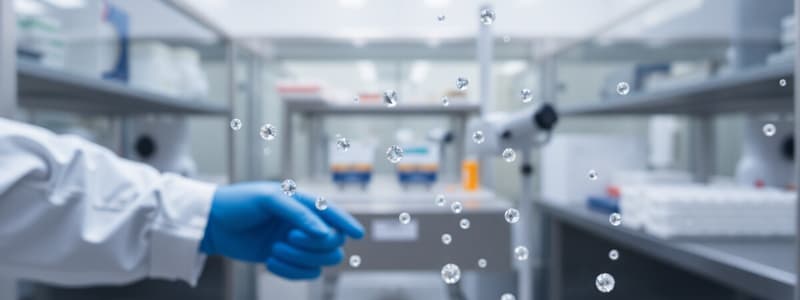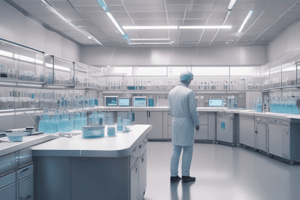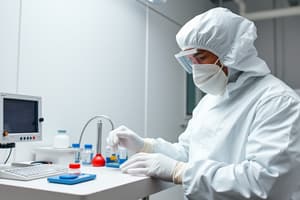Podcast
Questions and Answers
What is a key feature of the materials used in cleanroom construction?
What is a key feature of the materials used in cleanroom construction?
- They are lightweight and cheap.
- They are insulated for sound control.
- They produce minimal heat.
- They do not generate particles. (correct)
Which surgical practice was introduced by Lord Lister to reduce infection rates?
Which surgical practice was introduced by Lord Lister to reduce infection rates?
- Use of steam sterilization.
- Gowns for medical personnel.
- Regular hand washing.
- Germicidal air sprays. (correct)
What significant change occurred by 1900 regarding surgical practice?
What significant change occurred by 1900 regarding surgical practice?
- Mandatory use of antibiotics.
- Reduction in operating room sizes.
- Introduction of surgical gloves, masks, and gowns. (correct)
- Implementation of robotic surgery.
During which period was ventilation technology for cleanrooms notably developed?
During which period was ventilation technology for cleanrooms notably developed?
Which of the following contributed to a significant drop in the sepsis rate during hip replacement surgeries?
Which of the following contributed to a significant drop in the sepsis rate during hip replacement surgeries?
What was one primary finding concerning people in the context of cleanroom environments during the 1960s?
What was one primary finding concerning people in the context of cleanroom environments during the 1960s?
What is the primary focus of ISO Standard 14644-1?
What is the primary focus of ISO Standard 14644-1?
What was a notable advancement in cleanroom practices that emerged around World War II?
What was a notable advancement in cleanroom practices that emerged around World War II?
What is the primary purpose of a cleanroom as defined by ISO standard 14644-1?
What is the primary purpose of a cleanroom as defined by ISO standard 14644-1?
Which method is integral to maintaining air quality in a cleanroom?
Which method is integral to maintaining air quality in a cleanroom?
What is one of the main concerns for microbial contamination in a cleanroom environment?
What is one of the main concerns for microbial contamination in a cleanroom environment?
Which of the following is NOT a relevant parameter controlled in a cleanroom?
Which of the following is NOT a relevant parameter controlled in a cleanroom?
How does cleanroom technology ensure that no dirty air flows into the cleanroom?
How does cleanroom technology ensure that no dirty air flows into the cleanroom?
What is the main function of high-efficiency filters in a cleanroom?
What is the main function of high-efficiency filters in a cleanroom?
Which aspect of cleanroom design is critical for preventing particle generation?
Which aspect of cleanroom design is critical for preventing particle generation?
What cleaning method specifically aims to maintain cleanrooms by utilizing controlled processes?
What cleaning method specifically aims to maintain cleanrooms by utilizing controlled processes?
Which particle size is used to define ISO Class 5 classification?
Which particle size is used to define ISO Class 5 classification?
In the context of GMP EU classification, what is the maximum allowed particle count for Grade B at rest for particles larger than 0.5 μm?
In the context of GMP EU classification, what is the maximum allowed particle count for Grade B at rest for particles larger than 0.5 μm?
What is the particle concentration limit for a cleanroom defined under ISO Class 5 during its in-operation state?
What is the particle concentration limit for a cleanroom defined under ISO Class 5 during its in-operation state?
Why is classification inappropriate for particles in low concentrations?
Why is classification inappropriate for particles in low concentrations?
Which particle size descriptor is adapted for specifying particle sizes in association with ISO Class 5?
Which particle size descriptor is adapted for specifying particle sizes in association with ISO Class 5?
What condition distinguishes the 'As Built' classification state in cleanrooms?
What condition distinguishes the 'As Built' classification state in cleanrooms?
What specific requirement is imposed by EU GMP guidelines regarding cleanroom classification?
What specific requirement is imposed by EU GMP guidelines regarding cleanroom classification?
What is the particle count for Grade C cleanrooms in the in-operation state for particles larger than 5 μm?
What is the particle count for Grade C cleanrooms in the in-operation state for particles larger than 5 μm?
What is the acceptable microbial limit for Grade C cleanroom environments regarding air samples?
What is the acceptable microbial limit for Grade C cleanroom environments regarding air samples?
Which of the following biopharmaceuticals is derived from biological sources to treat human conditions?
Which of the following biopharmaceuticals is derived from biological sources to treat human conditions?
What is the primary benefit of recombinant DNA technology in insulin production?
What is the primary benefit of recombinant DNA technology in insulin production?
In a Grade A cleanroom, what is the microbial limit for glove prints?
In a Grade A cleanroom, what is the microbial limit for glove prints?
Which step is considered the challenging part of downstream processing in bioprocessing?
Which step is considered the challenging part of downstream processing in bioprocessing?
What is a common product of bioprocessing used in vaccines?
What is a common product of bioprocessing used in vaccines?
Which of the following grades has the highest acceptable limit for settle plates?
Which of the following grades has the highest acceptable limit for settle plates?
How are biopharmaceuticals defined?
How are biopharmaceuticals defined?
What is the maximum particle count for ISO class 3 at a size of ≥0.3 µm?
What is the maximum particle count for ISO class 3 at a size of ≥0.3 µm?
Which ISO class has a maximum of 10,000 particles/m³ for sizes ≥0.1 µm?
Which ISO class has a maximum of 10,000 particles/m³ for sizes ≥0.1 µm?
How many particles per cubic meter are allowed for ISO class 6 at sizes ≥0.5 µm?
How many particles per cubic meter are allowed for ISO class 6 at sizes ≥0.5 µm?
What is the maximum count for ISO class 8 for particles of size ≥5 µm?
What is the maximum count for ISO class 8 for particles of size ≥5 µm?
In terms of ISO standards, which class corresponds to a maximum of 1,000,000 particles/m³ for sizes ≥0.1 µm?
In terms of ISO standards, which class corresponds to a maximum of 1,000,000 particles/m³ for sizes ≥0.1 µm?
What is the maximum particle concentration for ISO class 7 at sizes ≥0.2 µm?
What is the maximum particle concentration for ISO class 7 at sizes ≥0.2 µm?
Which class indicates a maximum of 1,000 particles/m³ for sizes ≥0.1 µm?
Which class indicates a maximum of 1,000 particles/m³ for sizes ≥0.1 µm?
What is the maximum allowable concentration for ISO class 2 at sizes ≥5 µm?
What is the maximum allowable concentration for ISO class 2 at sizes ≥5 µm?
Flashcards
Cleanroom
Cleanroom
A room that controls airborne particle concentration by minimizing introduction, generation, and retention of particles, along with controlling other parameters like temperature and humidity.
Particle Control
Particle Control
The key goal of a cleanroom is to limit the number of airborne particles by stringent filtration and material selection.
Air Filtration
Air Filtration
Using high-efficiency filters in a cleanroom supply system to remove particles and bacteria.
Pressure Control
Pressure Control
Signup and view all the flashcards
Material Selection
Material Selection
Signup and view all the flashcards
ISO 14644-1
ISO 14644-1
Signup and view all the flashcards
Microbial Contamination
Microbial Contamination
Signup and view all the flashcards
Cleanroom Applications
Cleanroom Applications
Signup and view all the flashcards
ISO 14698
ISO 14698
Signup and view all the flashcards
FED STD 209E
FED STD 209E
Signup and view all the flashcards
Particle Size
Particle Size
Signup and view all the flashcards
Cumulative Concentration
Cumulative Concentration
Signup and view all the flashcards
ISO 1
ISO 1
Signup and view all the flashcards
ISO 9
ISO 9
Signup and view all the flashcards
Cleanroom Equivalent
Cleanroom Equivalent
Signup and view all the flashcards
Matching FED to ISO
Matching FED to ISO
Signup and view all the flashcards
Lord Lister's Contribution
Lord Lister's Contribution
Signup and view all the flashcards
Aseptic Techniques
Aseptic Techniques
Signup and view all the flashcards
Why Cleanrooms?
Why Cleanrooms?
Signup and view all the flashcards
Cleanroom Standards
Cleanroom Standards
Signup and view all the flashcards
Ventilation in Cleanrooms
Ventilation in Cleanrooms
Signup and view all the flashcards
Airborne Samplers
Airborne Samplers
Signup and view all the flashcards
People as Infection Sources
People as Infection Sources
Signup and view all the flashcards
Microbial Limits
Microbial Limits
Signup and view all the flashcards
Alert Limit
Alert Limit
Signup and view all the flashcards
Action Limit
Action Limit
Signup and view all the flashcards
Bioprocessing
Bioprocessing
Signup and view all the flashcards
Biopharmaceutical
Biopharmaceutical
Signup and view all the flashcards
Recombinant DNA
Recombinant DNA
Signup and view all the flashcards
Upstream Processing
Upstream Processing
Signup and view all the flashcards
Downstream Processing
Downstream Processing
Signup and view all the flashcards
ISO Class 5
ISO Class 5
Signup and view all the flashcards
0.3 μm
0.3 μm
Signup and view all the flashcards
Macroparticle Descriptor 'M'
Macroparticle Descriptor 'M'
Signup and view all the flashcards
Sequential Sampling
Sequential Sampling
Signup and view all the flashcards
GMP EU Classification
GMP EU Classification
Signup and view all the flashcards
'As Built' State
'As Built' State
Signup and view all the flashcards
'At Rest' State
'At Rest' State
Signup and view all the flashcards
'In Operation' State
'In Operation' State
Signup and view all the flashcards
Study Notes
Applied Microbiology/Pharmaceutical Microbiology and Cleanroom Technology
- Gillian Carney, [email protected], Room 1163
- Focuses on applied microbiology, pharmaceutical microbiology, and cleanroom technology.
Cleanroom Technology - Overview
- Covers history and bioprocessing
- Discusses cleanroom design and contamination
- Explains cleaning methods
- Examines resistance to disinfectants
- Explores clean-in-place strategies
- Examines monitoring techniques in cleanrooms
- Details endotoxins and LAL assays
- Outlines cleanroom operation
Activity
- Students need to summarise microbial contamination and air pollution concerns in cleanroom environments and control methods.
- Students need to identify industries where cleanroom technology is used and justify its importance in these settings.
Cleanroom Technology (What is a Cleanroom?)
- Defined in ISO standard 14644-1.
- A room where airborne particle concentration is controlled, minimizing introduction, generation, and retention of particles.
- Critical parameters, e.g., temperature, humidity, and pressure, are controlled as needed.
- Essentially, a cleanroom minimizes particle introduction, generation, and retention.
- Air supplied is filtered with high-efficiency filters, tightly controlling parameters like temperature, humidity, etc.
- Materials used do not generate particles and are easily cleaned.
- Cleanroom personnel use clothing that minimizes particle and microorganism dispersal.
- Cleanrooms also control temperature, humidity, sound, lighting, and vibration.
History of Cleanrooms (1860s-1900s)
- 1860s-1900s (hospitals):
- Lord Lister identified bacteria as the cause of surgical wound infections.
- Antiseptic solutions (carbolic acid) were used.
- 1889 Aberdeen Royal Infirmary used Lister's spray (carbolic acid) in the operating room.
- 1890s Royal Infirmary Edinburgh introduced gowns.
- Techniques for aseptic techniques, boiling instruments and bandages, and improved handwashing were developed.
- By 1900, surgical gloves, masks, and gowns were introduced (steam sterilized before use).
- 1940s:
- Ventilation was introduced in temperate climates.
- Major problem in crowded situations (e.g., submarines, air raid shelters).
- Airborne samplers helped understanding contamination dynamics.
- Most key principles of cleanroom technology developed.
- This period highlighted the importance of people as a major source of infection.
- 1960s-1970s:
- Charnley & Howorth: Hip replacements, 10% sepsis rate initially, improved to <1% by 1970 with controlled air flow in restricted areas.
History of Cleanrooms (Industrial cleanrooms)
- World War II:
- Improved quality of weapons and vehicles.
- Nuclear fission led to the use of HEPA filters for radioactive contaminants.
- 1961:
- Sandia Laboratories introduced unidirectional (Laminar flow) concept.
Modern Cleanrooms
- Cleanroom technology is crucial for medical settings and product manufacturing.
- Industries using cleanrooms include: semiconductor, optics, medical devices, biopharmaceuticals, pharmaceuticals, food & drink.
- Products include integrated circuits, lenses, heart valves, insulin, vaccines, aspirin, and brewery production.
- Cleanrooms are classified based on the cleanliness of the air (e.g., Federal Standard 209 and ISO 14644-1).
Classification and Standards
- Cleanrooms are classified by air cleanliness, using standards like Federal Standard 209 and the ISO 14644-1 standard.
- Airborne particle concentration, given in metric units, is logarithmic. Particles larger than 0.5 µm per m3 are considered.
- A series of cleanroom standards including design, testing, operation, and biocontamination. Published in 1999.
- ISO 14698 is now a key documentation for the cleanroom system.
Monitoring of Microbial Limits
- Microbial limits are monitored.
- Appropriate alert and action limits are set for each cleanroom environment.
- Specifications for air samples or settle plates, contact plates, and glove prints are defined by grade (A, B, C, D).
Bioprocessing
- Bioprocessing uses organisms and biologically derived molecules to manufacture products.
- Biopharmaceuticals are biological medical products derived from organisms, having the purpose to diagnose, treat, prevent or cure diseases or conditions in human beings(e.g., proteins, vaccines, cell therapies).
- Insulin production, as an example, used to involve extracting from animals; Recombinant DNA technology now allows production using microorganisms.
Bioprocessing e.g. Production of Insulin
- Insulin, used for Type-1 diabetes (31,000 new cases per year in the EU), production methods have evolved.
- Previously isolated from animals.
- Recombinant DNA technology allows production of human insulin using microorganisms.
Bioprocessing Steps
- Upstream processing, primary capture & recovery, downstream processing, final sterilization and filling and formulation.
Cleanroom Features
- Cleanrooms have smooth unbroken surfaces and seamless, rounded joints for easy cleaning.
- Durable, chemical resistant materials are used for cleanroom construction.
- Airlocks and automatic doors help maintain cleanroom conditions.
- Air circulation systems help to remove contaminants.
Occupancy States and GMP EU Classification
- Cleanrooms are classified based upon their occupancy state (as built, at rest, in operation).
- GMP EU classification outlines standards for particle counts in a cleanroom. Different occupancy states result in different maximum particle counts per cubic metre.
Studying That Suits You
Use AI to generate personalized quizzes and flashcards to suit your learning preferences.




